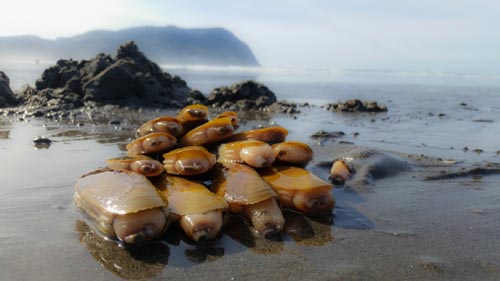Beach Bummer: Razor Clamming on N. Oregon Coast Remains Closed
Published 09/28/2018 at 6:54 PM PDT
By Oregon Coast Beach Connection Staff

(Seaside, Oregon) – There is some bad news for razor clamming on the north Oregon coast: the most plentiful section of beaches will remain closed to harvesting for awhile longer. (Clam photos courtesy Seaside Aquarium).
Includes exclusive listings; some specials in winter
In Cannon Beach:
Includes rentals not listed anywhere else
In Manzanita, Wheeler, Rockaway Beach:
Some specials for winter
In Pacific City, Oceanside:
Some specials for winter
In Lincoln City:
Some specials for winter
In Depoe Bay, Gleneden Beach:
Some specials for winter
In Newport:
Look for some specials
In Waldport
Some specials for winter
In Yachats, Florence
Some specials for winter
Normally, the population conservation closure on Clatsop beaches starts on July 1 and runs until September 30. Oregon Department of Fish and Wildlife (ODFW) has postponed that restart, however, due to stock assessments that have not yielded decent numbers and sizes of razor clams. November 1 is the earliest that razor clamming will be allowed – perhaps even later.
Clatsop beaches account for nearly 90 percent of the entire population of razor clams on the Oregon coast.
ODFW’s survey of the razor clam population found that most are still too small to be harvested by commercial clammers or desired by recreational clammers. Normally, the halt on razor clamming in this area lasts from July through the end of September so populations can rebuild. Periodically, problems are found and the ban is extended.
This annual conservation and its extension apply only to Clatsop County beaches, prohibiting all harvest of razor clams (both recreational and commercial) along the 18 mile stretch of beach from Tillamook Head (Seaside) to the mouth of the Columbia River.
“Razor clams are moderately abundant on Clatsop beaches this fall, but the population is currently dominated by small clams with shell lengths between 2-3 inches,” said ODFW Shellfish Biologist Matt Hunter. “Recreational clammers typically try to avoid these small clams, and they are smaller than the 3 ¾” minimum size allowed for commercial harvest.”
ODFW recently completed the annual stock assessment survey for razor clams along the Clatsop beaches. The survey found that most clams are too small to be harvested by commercial clammers or desired by recreational clammers.
Hunter said that far more small razor clams are in the current population than normal.
“In 2004, we also saw large numbers of small razor clams along Clatsop beaches, but they were more variable in size with a few medium and large clams,” he said. “Right now, it is difficult to find any razor clams larger than 4 inches.”
Washington’s sister agency, the Washington Department of Fish and Wildlife, found a similar issue with clams on the Washington coast. Traditionally, that state opens razor clam digging back up around this time as well, but this year it has been postponed until December. ODFW said the clam populations on this part of the Oregon coast are in even worse shape than that of the Long Beach Peninsula.
ODFW is examing several options, including keeping the closure in place through December to allow clams to grow in a suitable size. During the month of October, ODFW staff will hold a public meeting to solicit feedback regarding potential management actions that may be taken to protect undersize clams and provide better clamming opportunities next spring.
The entire Oregon coast reaminsl open for bay clams and crab harvesting. Mussels are open for recreational harvest along most of the Oregon coast, although harvesting of mussels is closed from the south jetty of the Coquille River to the California border. For more information please call ODA's shellfish safety information Hotline at (800) 448-2474 or visit the ODA Recreational Shellfish Biotoxin Closures webpage or ODFW’s Recreation Report – Crabbing and Clamming page. Oregon Coast Lodgings for this - Where to eat - Maps - Virtual Tours
Cannon Beach Lodging
Nehalem Bay Lodgings
Manzanita Hotels, Lodging
Three Capes Lodging
Pacific City Hotels, Lodging
Lincoln City Lodging
Depoe Bay Lodging
Newport Lodging
Waldport Lodging
Yachats Lodging
Oregon Coast Vacation Rentals
Oregon Coast Lodging Specials




More About Oregon Coast hotels, lodging.....
More About Oregon Coast Restaurants, Dining.....
LATEST Related Oregon Coast Articles
Likely just before dawn best hour but peak happens during daylight. Weather
Dark Sky Week is Prime Along Oregon Coast: Where and Where Not to Go
General guide to dark sky viewing from south to north coast. Astronomy
Sizable Price Drop, Deals in Lincoln City During Quiet of April on Central Or...
20 perc off at A1 Vacation Rentals across its roster, including Gleneden Beach. Lincoln City specials
Upcoming S. Oregon Coast Events Include Gem Show, History: Coos Bay, Bandon
May 6 talk at Coos History Museum, Mayfly Fest May 17, Bandon Rock / Gem Show June 7,8
Washington Coast Cleanup on April 19 - Coinciding with Oregon Coast's SOLVE E...
From the Puget Sound to Long Beach, alongside Oregon's cleanup. Washington coast events, Seaside events
Astoria's Riverwalk Gets New Lighting, More N. Oregon Coast Roadwork
Delays coming this summer, but the riverwalk has a new look. Seaside, Cannn Beach
April Gets Even Cheaper Midweek at Depoe Bay, Lincoln City: Oregon Coast Deals
Off-season rates plus more at Keystone Vacation Rentals. Depoe Bay lodging specials, Lincoln City hotel reviews, Newport hotel reviews
Washington Coast Begins Week of Clam Digs, April 12 Through 18
Long Beach, Twin Harbors, Mocrocks and Copalis at different times. Washington coast events
Back to Oregon Coast
Contact Advertise on BeachConnection.net
All Content, unless otherwise attributed, copyright BeachConnection.net Unauthorized use or publication is not permitted














































